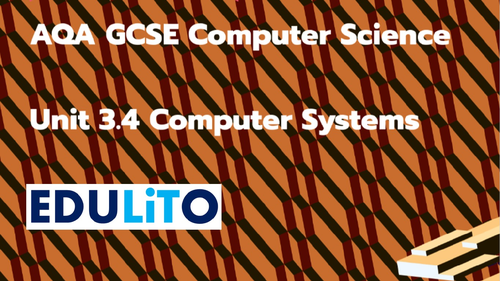










These adaptable PowerPoint Presentations (219 Slides) cover all aspects of the specification in relation to AQA GCSE Computer Science 8525 (from 2020) component 3.4.
It includes:
Teaching PowerPoints (including checkpoint questions and answers) -
Student PowerPoints (Including checkpoint questions, but omits the answers)
Content Covered:
Define the terms hardware and software and understand the relationship between them.
Construct truth tables for the following logic gates:
• NOT
• AND
• OR
• XOR.
Construct truth tables for simple logic circuits using combinations of NOT, AND, OR and XOR gates.
Interpret the results of simple truth tables.
Create, modify and interpret simple logic circuit diagrams.
Students will only need to use NOT, AND, OR and XOR gates within logic circuits.
Students will be expected to understand and use the standard logic circuit symbols.
Create and interpret simple Boolean expressions made up of NOT, AND, OR and XOR operations.
Create the Boolean expression for a simple logic circuit.
Create a logic circuit from a simple Booleanexpression.
Explain what is meant by:
• system software
• application software.
Give examples of both types of software.
Understand the need for, and functions of, operating systems (OS) and utility programs.
Understand that the OS handles management of the:
• processor(s)
• memory
• input/output (I/O) devices
• applications
• security.
Know that there are different levels of programming language:
• low-level language
• high-level language.
Explain the main differences between low-level and high-level languages.
Know that machine code and assembly language are considered to be low-level languages and explain the differences between them.
Understand that all programming code written in high-level or assembly languages must be translated.
Understand that machine code is expressed in binary and is specific to a processor or family of processors.
Understand the advantages and disadvantages of low-level language programming compared with high-level language programming.
Understand that there are three common types of program translator:
• interpreter
• compiler
• assembler.
Explain the main differences between these three types of translator.
Understand when it would be appropriate to use each type of translator.
Explain the role and operation of main memory and the following major components of a central processing unit (CPU) within the Von Neumann architecture:
• arithmetic logic unit
• control unit
• clock
• register
• bus.
Explain the effect of the following on the performance of the CPU:
• clock speed
• number of processor cores
• cache size.
Understand and explain the Fetch-Execute cycle.
Understand the different types of memory within a computer:
• RAM
• ROM
• Cache
• Register.
Know what the different types of memory are used for and why they are required.
etc
Get this resource as part of a bundle and save up to 30%
A bundle is a package of resources grouped together to teach a particular topic, or a series of lessons, in one place.
Something went wrong, please try again later.
This resource hasn't been reviewed yet
To ensure quality for our reviews, only customers who have purchased this resource can review it
Report this resourceto let us know if it violates our terms and conditions.
Our customer service team will review your report and will be in touch.